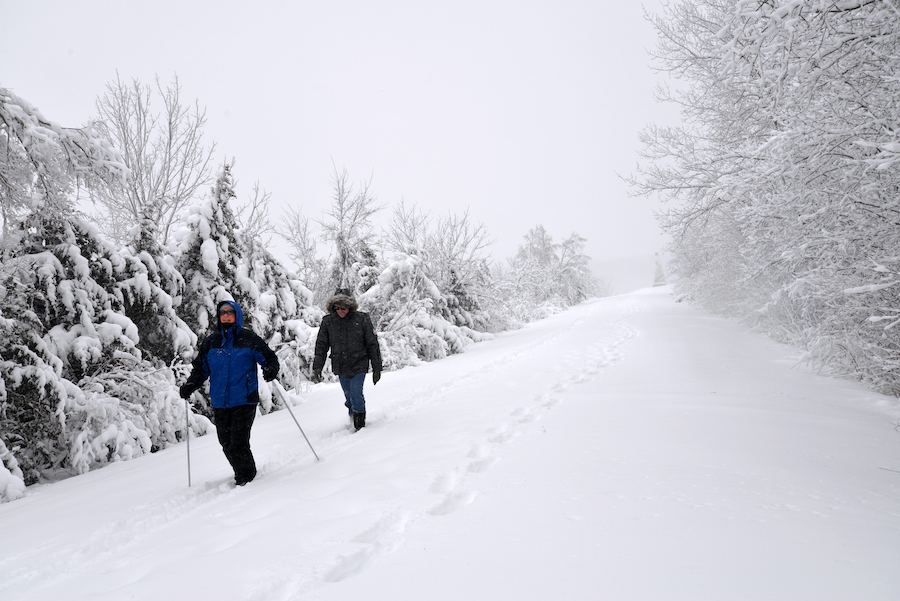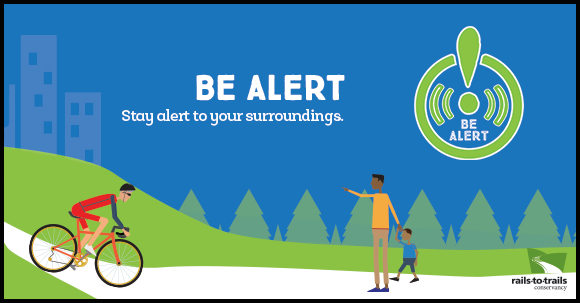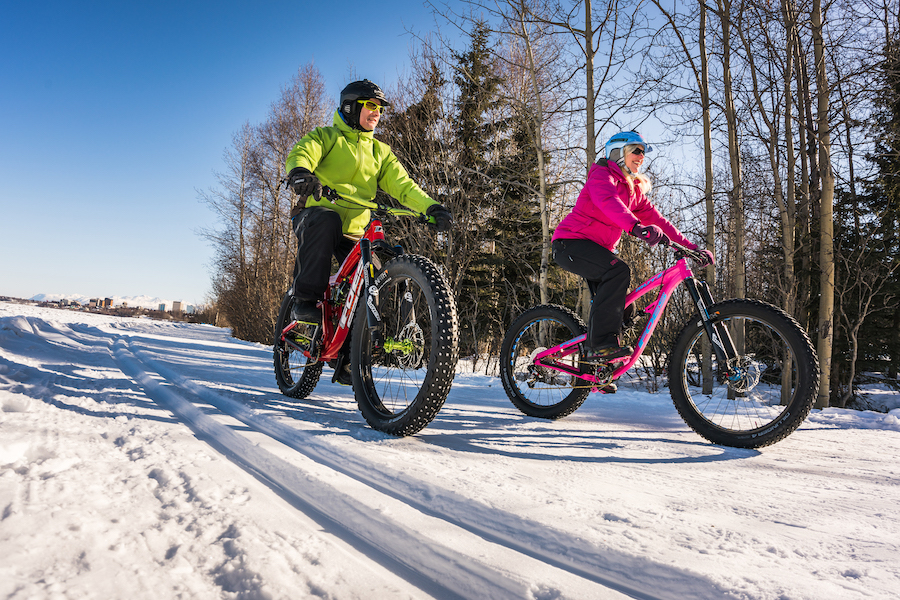Winter “Share the Trail” Etiquette and Safety Tips

If you live in a place that experiences snow and colder weather in the winter months, then you know that winter can be a glorious, but also slightly more challenging, time to be active in the outdoors. In addition to specific health considerations that come with being out in frigid conditions, the varied mix of different modes on the trail, from cross-country skiing to dogsledding, makes it extra imperative to be conscientious and courteous while out on our favorite local pathways.
This article was updated on Jan. 7, 2025.

We chatted with some of Rails to Trails Conservancy’s most knowledgeable winter trail aficionados to find out how we can all “Share the Trail” together safely—while still gleaning the best that winter has to offer on America’s trails. Check out the highlights below.
And if you’re looking for other great information and details on how to winterize your trail experience, check out our recent blog.

Gear Up And Water Up
For anyone seeking safe outdoor experiences on trails in the cold and winter months, dressing appropriately and being prepared are key. Tom Sexton, director of RTC’s Northeast Region, recommends wearing layers (synthetic wicking materials are best), and starting out just a little cool so you don’t overheat and sweat once you get going. A backpack is also handy if you need to shed an outer layer.
Eric Oberg, RTC’s senior director of programs, throws out another golden rule for winter trail use: “Stay hydrated on the inside, and dry on the outside.”
It’s not always intuitive, affirmed Oberg, but it’s just as important to get plenty of fluids in 10 degree weather as it is in 90 degree weather, especially when you’re being physically active.
Learn more from the experts on how to adapt your trail experience to cold and winter conditions.
Tip 1: All the Rules of Good Trail Etiquette Still Apply

“A helpful piece of advice for people out on the trail is to let go of the idea of ‘winter’ as being unique with regard to trail use, and think of it as another season of opportunities to be out and about—but with a few more considerations for the colder and wetter conditions,” said Eric Oberg, senior director of programs for RTC. “Remember that when it comes to being safe, all the things you’d do in the summer or warmer months of the year still apply. You still want to ask yourself, ‘What’s the level of my impact on other users,’ and make sure you are aware of your surroundings.”
Through its “Share the Trail” campaign, RTC promotes six “golden rules” for trail building, including:






Recognizing the importance of being good trail stewards, RTC along with the national #RecreateResponsibly campaign also provide these winter-friendly safety, health and stewardship tips for a positive experience on the trail.
Wheels (and Sleds) Yield to Heels (But Not Always)

The long-standing rule of the trail that “Wheels yield to heels” still applies in snow, but with some additions, of course. In general, slower or more vulnerable trail users should get the right of way from faster and/or less vulnerable trail users, with typical non-winter conditions looking like this:
BICYCLISTS yield to → INLINE SKATERS who yield to → WALKERS AND RUNNERS who yield to → HORSEBACK RIDERS
In the winter, said Oberg, the accessibility factors of various snow-related sports—including fat-tire biking, cross-country skiing, snowmobiling and, yes, even the occasional dog sledder—means that while these trail users will certainly be out in higher numbers, the main increases in trail use will be from walkers, wheelchair users and, potentially, snowshoers.
That said, the yielding rules take on a similar format to that of the summer …
SNOWMACHINES yield to → BICYCLISTS who yield to → DOG SLEDDERS who yield to → CROSS-COUNTRY SKIERS who yield to → SNOWSHOERS, WALKERS and RUNNERS who yield to → HORSEBACK RIDERS
But there are number of caveats—related to hills, speed and route.
For many flat, straight rail-trails, it’s often appropriate for the faster-moving trail user to stop and/or slowly move around the slower (or less experienced) trail user in front of them—but, it depends on their level of control, the situation and the conditions.
When it comes to cross-country skiers or dog sledders, those moving downhill should always have the right-of-way versus those who are moving uphill, simply because it’s harder for the downhill user to stop. Additionally, trail users may encounter situations where fast-moving skiers and dog sledders are coming up behind you, and the ease of stepping aside without conflict are easier for the slower moving individual. In those cases—when appropriate—it’s nice to step aside.
As REI stated in this guide to winter trail etiquette, “right-of-way comes down to common sense,” and “[b]eing polite and conscientious will get you far.”
Be Extra Alert

“When you’re [out on the trail in the snow], you have to be listening,” said Willie Karidis, who serves as the project director for the 700-mile Route of the Badger trail network in Wisconsin.
Tom Sexton, director of RTC’s Northeast Office, agrees—adding that trail users should “think twice about [wearing] ear buds” in the winter and in colder weather—“which can leave you even more compromised [in terms of your ability to hear what’s around you] once you stick a hat or ear muffs over top of them.”
The reality is that trail users on sleds or skis can be extremely quiet on the ground, said Oberg. Adding to that—while most trail users are likely to hear a snow machine far earlier than they encounter it, the person on the snow machine likely won’t hear you, and visibility issues in the winter or bends in the trail could also impede sight. This means that while general rail-trail etiquette states that faster should yield to slower, vigilance on all sides is recommended.
“Ultimately, everyone is out to have a good time,” said Sexton. “Snowmobile users have been perceived negatively in the past because they are motorized, but the snowmobiling clubs and associations truly love these pathways and volunteer to maintain the trails year-round for the privilege of using them in the wintertime. A lot of people recognize the amount of effort that snowmobile clubs are putting in to make summer use more enjoyable.”
And, in the end, respect for each other is what having a great trail experience is all about.
Know Before You Go

Whether you are out stretching your legs, or you’re seeking some winter wonderland adventure, you’ll be ahead of the game by doing your research before setting out. True in any weather—most trails across the United States specify permitted uses, and many trails have clear guidelines for fat-tire bicycling, cross-country skiing, dog sledding and snowmobile use.
In some cases, the local trail manager may groom the trail for certain months out of the year for cross-country skiing. Other trail managers may be plowing (mainly in metro areas) or packing their trails to enable more local residents to access safe places to walk, run or bike.
RTC’s free trail-finder website and mobile app, TrailLink.com, lists information on 42,000 miles of multiuse trails across the country, and is a good place to go to search for local trail manager websites and contacts to determine if a trail is right for you.
Be Kind to Others

“One thing I love more than anything … is fresh snow,” said Karidis, who lived in Alaska for 25 years. “[I love] the fresh powder, breaking trail in the early morning—you get to see the sunrise … I’m in heaven.”
Part of it is about safety, he said, adding that fresh snow is less icy, providing better grip for both snowshoes and skis (on ungroomed trails), and “if you fall over—you’re falling into fresh powder. You’ll be working harder … maybe 10 times harder with snowshoes, but it will feel so much better.”
But if you’re not an early riser—or you’re on a groomed trail—Karidis encourages those individuals who are walking, biking or on snowshoes to keep to the side and off the ski tracks, so as not to damage the route for other trail users. Snowshoers might even decide to explore off the trail when encountering a park or open natural area. “Make your own trail,” said Karidis. That’s where you find the best discoveries.”
And of course, the benefits of being a good trail steward can’t be understated—in all four seasons. “If you see a branch or small impediment that you can easily take care of on your own, go for it,” said Karidis. “It makes for a nicer experience [for everyone.]”
Special acknowledgments: Eric Oberg, Willie Karidis, Tom Sexton
Winter Trail Tips
- Wintertime Trail Fun
- Winter “Share the Trail” Etiquette and Safety Tips
- Seven Hot Tips for Cold-Weather Biking / Siete buenos consejos para andar en bicicleta en climas fríos
- Rail-Trail Tips for Cross-Country Skiing (A 101 Guide) / Consejos para senderos ferroviarios para esquí de fondo (una guía 101)
- The Magical World of Snowshoeing: A How-To Guide for Trails) / El mágico mundo de las raquetas de nieve: una guía práctica para senderos
- How to Adapt Trail Activities and Gear for Cold and Winter Conditions
- 10 Rail-Trail Winter Wonderlands

Donate
Everyone deserves access to safe ways to walk, bike, and be active outdoors.